Fentanyl Crisis
Health orgs distribute Fentanyl test strips & Narcan in WeHo
Activists and members of health organizations hand out life-saving Fentanyl Test Strips and Naloxone nasal sprays
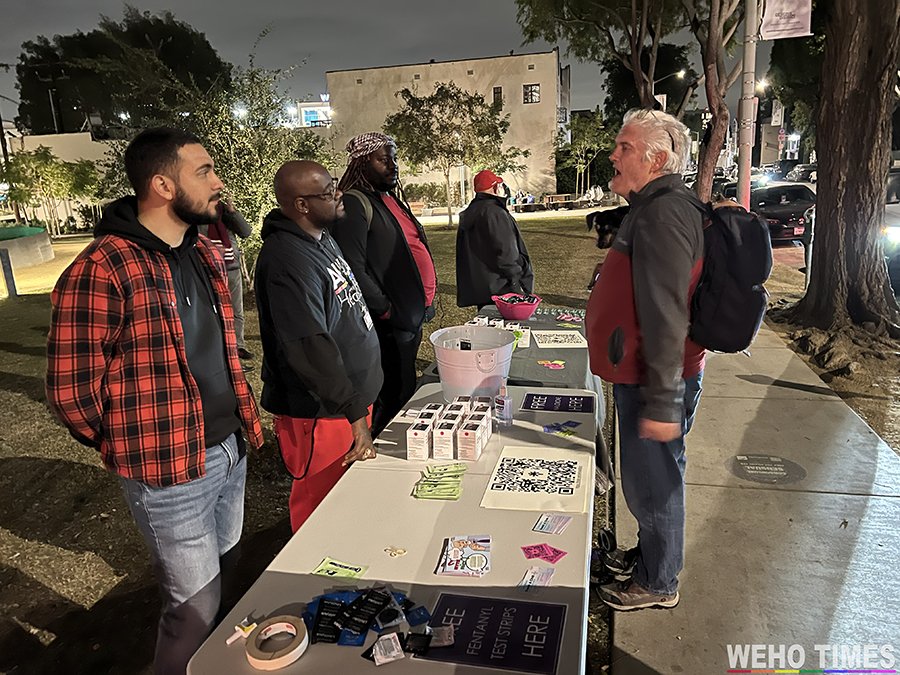

By Paulo Murillo | WEST HOLLYWOOD – The Institute for Public Strategies’ West Hollywood Project joined activists and members of health organizations Being Alive Los Angeles, LGBT Center’s Trans Wellness Center, AHF, The Wall Las Memories APLA Health, Los Angeles Centers for Alcohol and Drug Abuse (LA CADA), and Los Angeles Department of Public Health to distribute overdose prevention information and resources along with life-saving Fentanyl Test Strips and Naloxone nasal sprays.
The group gathered for an evening of engaging with the public to discuss the dangers of drug use on National Meth Awareness Day, on Wednesday, November 30, 2022, at West Hollywood Park facing Robertson Boulevard (Next to The Abbey Food & Bar).

The West Hollywood Project recognized National Meth Awareness by hosting two events, one in Silverlake (at Akbar, located at 4356 Sunset Blvd), and the other at West Hollywood Park at 647 N. San Vicente Boulevard (picnic area near Robertson Boulevard), beginning at 7:30 p.m. (there is an additional event at Stache WeHo, 8941 Santa Monica Blvd.)
Volunteers set up two tables to and offered resources on drug addiction and provided information on harm reduction, along with tools individuals could use for themselves or offer to a friend.

“We’re engaging the community and giving away free fentanyl test strips and Narcan for education and to raise awareness, “said Daniel Ruiz of West Hollywood’s Institute of Public Strategies “We are also offering condoms and lube and we also have other organizations here that are part of the coalition.”

“I’m out here with APLA Health, and not only are we providing the Narcan and the test strips, but we’re also out here as a resource,” said Luckie Alexander, “I’m also working with the Trans Wellness Center, so if anyone comes out here and needs other services, especially our trans folks, I’m providing those services and giving them contact information. We just ask them if they want the Narcan or the test strips and a lot of folks are really responding. We know those folks are going to be safe and live another day. This is about harm reduction, having access to these things and knowing what to do with it. Folks really appreciated.”

Alexander added that there this was a judgment-free space and that they weren’t telling anyone to stop doing drugs, but to help them take better care of themselves.
The West Hollywood Project is an ongoing, centralized effort to help promote Alcohol and Drug (AOD) Free events, activities and civic opportunities in the West Hollywood area. They promote specific events such as #SIZZLE! at LA Pride and #BOOM!, the annual New Year’s Eve event in West Hollywood. The West Hollywood Project is a Project of the Institute for Public Strategies and funded by the Los Angeles County Department of Public Health, Substance Abuse Prevention and Control.
A national survey found one out of six young adults has used illicit drugs in the last month. Brain scientists now know why just one use of crystal meth (methamphetamine) can make a person feel hooked.
The National Meth Awareness day is an effort to send a prevention message to potential meth users. It also gets the message out about available programs to current users. In some parts of the country, meth use is increasing while in others it continues to rise.
Part of the reason meth is so addictive is it increases the amount of dopamine in the brain. Dopamine occurs naturally in our brains. It affects our body’s reward centers as well as our movement, motivation, and reinforcement. It’s the impact on this area of the brain that makes methamphetamine so addictive.
Beyond the short-term effects of alertness, increased physical activity, reduced or no appetite, rapid heart rate and increased blood pressure, continued use of methamphetamine has long-term health effects.
- risk of diseases transmitted through needles
- addiction
- extreme weight loss
- dental problems including tooth loss and gum disease
- sleeping disorders
- memory loss
- anxiety
- skin issues
- hallucinations
- paranoia
However, there is help. Visit Substance Abuse and Mental Health Services Administration (SAMSA) to learn about the referral program. It’s available 24 hours a day, 7 days a week. The page is full of resources for adults, teens, and family members. There, you can find support for yourself and others who may be facing addiction. There is a way out and a life after addiction. Visit the helpline at: https://www.samhsa.gov/find-help/national-helpline.
In a proclamation signed by President George W. Bush in 2006, November 30th was set forth as National Meth Awareness Day. The observance serves two purposes. First, it aims to reach potential users with prevention methods. Second, the day increases awareness of programs and services available to current users.
*******************************
Paulo Murillo is Editor in Chief and Publisher of WEHO TIMES. He brings over 20 years of experience as a columnist, reporter, and photo journalist.
The preceding article was previously published by WeHo Times and is republished with permission.
Fentanyl Crisis
Newsom releases master plan for tackling Fentanyl & Opioid crisis
Governor Newsom has invested over $1 billion to tackle the crisis Through CalRx, California will seek to manufacture its own Naloxone
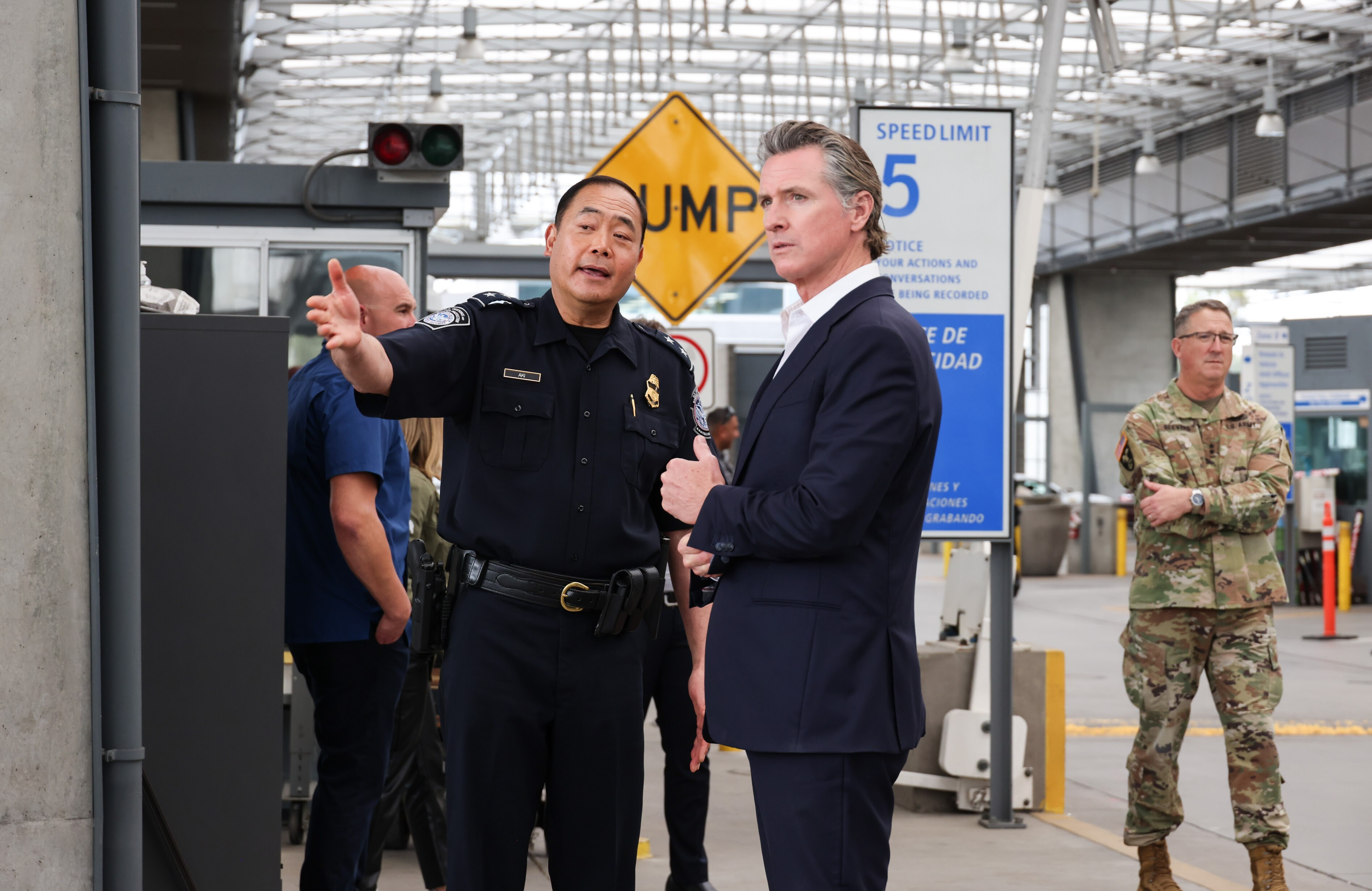
SAN DIEGO COUNTY – Following a visit to the San Ysidro Port of Entry, Governor Gavin Newsom released his administration’s Master Plan for Tackling the Fentanyl and Opioid Crisis on Monday.
Recognizing the opioid and fentanyl crisis as a multifaceted public health and public safety issue, Governor Newsom’s Master Plan provides a comprehensive approach to save lives. The Master Plan builds on the Governor’s $1 billion investment to tackle this crisis — including an expansion of California National Guard-supported operations that last year led to a 594% increase in seized fentanyl.
The Master Plan outlines aggressive steps to support overdose prevention efforts, hold the opioid pharmaceutical industry accountable, crack down on drug trafficking, and raise awareness about the dangers of opioids, including fentanyl.
“Over 150 people die every day in our nation from overdoses and poisonings related to synthetic opioids like fentanyl. Enough. With this Master Plan, California is doubling down to combat this crisis and save lives. Our comprehensive approach will expand enforcement efforts to crack down on transnational criminal organizations trafficking this poison into our communities — while prioritizing harm reduction strategies to reduce overdoses and compassionately help those struggling with substance use and addiction,” the Governor said.
The Newsom Administration has invested over $1 billion to crack down on opioid trafficking and enforce the law, combat overdoses, support those with opioid use disorder, and raise awareness about the dangers of opioids. The Master Plan provides a comprehensive framework to deepen the impact of these investments — including through a new CalRx effort where California will seek to manufacture its own opioid overdose reversal drug Naloxone.
California will further save lives through an additional $96 million in funding in the Governor’s 2023-24 proposed budget:
- $79 million for the Naloxone Distribution Project to meet increased demand and provide more Naloxone to communities than ever before;
- $10 million for grants for education, testing, recovery, and support services;
- $4 million to make fentanyl test strips more widely available; and
- $3.5 million in Prop 98 funding to provide overdose medication to all middle and high schools.
These new investments, coupled with the extensive abatement, enforcement, and treatment efforts outlined in the Master Plan will save lives and make California safer.
The U.S. has faced an evolving crisis of opioid addiction, overdose, and death for over two decades, driven by Big Pharma’s irresponsible marketing of prescription opioids – bringing the United States to today’s fentanyl crisis.
Millions of Americans suffer from opioid use disorder and more than 71,000 Americans died in 2022 alone from fentanyl-linked overdoses and drug poisonings. According to the Drug Enforcement Administration, a vast majority of fentanyl in the U.S. comes via ports of entry at the border – through trafficking by organized crime rings, not by migrants.
California has worked aggressively to tackle the opioid crisis. In the current fiscal year alone, the California Health and Human Services agency is investing $450 million in treatment, abatement, and prevention efforts.

(Photo Credit: Office of the Governor)
The 2022 Budget Act Governor Newsom signed into law included $30 million to expand the California Military Department’s existing drug interdiction efforts to thwart drug-trafficking transnational criminal organizations throughout the state, with a particular focus on assisting federal, state, local, and tribal law enforcement agencies in combatting fentanyl. To support the Governor’s initiative to reduce deadly fentanyl in communities, the California National Guard has hired, trained, and embedded 144 new members.
View the Master Plan (here).
Fentanyl Crisis
Calif. bill to strengthen penalties for Fentanyl trafficking introduced
AB 367 will be heard in policy committees later this spring and will move on to the Assembly floor this summer
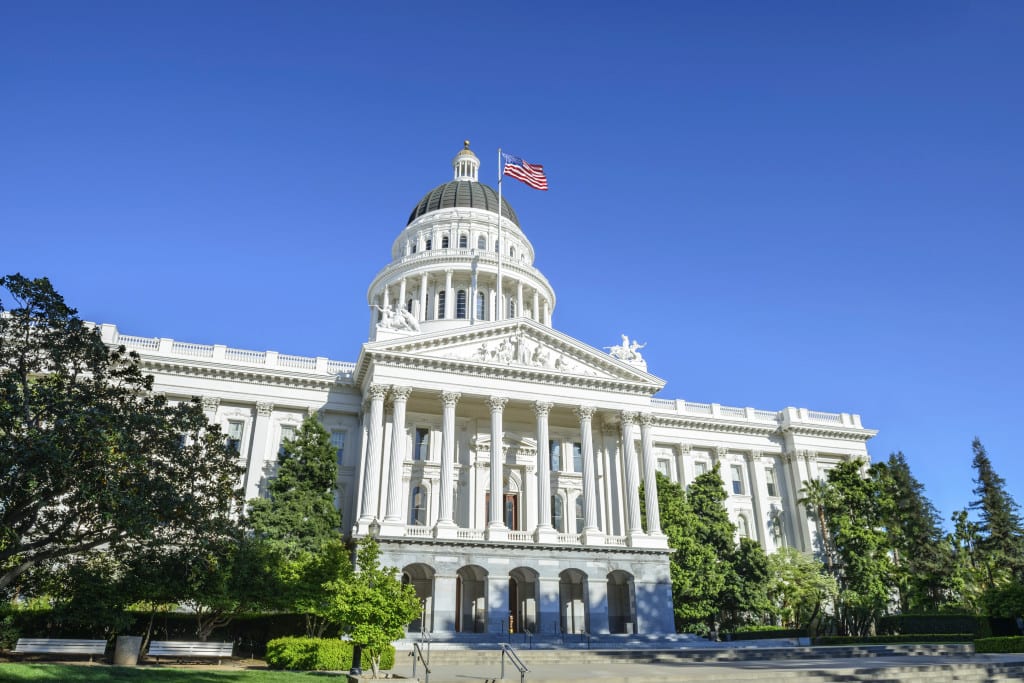
SACRAMENTO – Assemblymember Brian Maienschein introduced legislation this week to help California take action to stop drug traffickers from contributing to the fentanyl epidemic.
Fentanyl overdoses have spiked across the nation in recent years. In California, over 5,700 fentanyl-related deaths were reported in 2021 alone. According to the California Department of Public Health, fentanyl is up to 50 times stronger than heroin and 100 times stronger than morphine. An alarming increase in counterfeit pills and other illicit substances being sold on the drug trafficking market have been laced with a fatal amount of fentanyl, leading to thousands of deaths and serious injuries.
Assembly Bill 367 will provide stronger criminal penalties for individuals who sell or otherwise furnish controlled substances, such as fentanyl, that result in great bodily injury or death.
“Fentanyl has had devastating effects in San Diego County and throughout the state, and the data shows us that action to address this epidemic is critically overdue,” said Assemblymember Maienschein. “My bill would help California hold drug dealers accountable for the destruction and trauma they cause by knowingly distributing this deadly substance.”
Last year, San Diego Mayor Todd Gloria signed an executive order calling for bold action by state and federal lawmakers to help the region and the state address the fentanyl emergency. Assemblymember Maienschein has partnered with Mayor Gloria on AB 367 to take the necessary steps to address this crisis in San Diego County and throughout California.
“The nationwide proliferation of illicitly manufactured fentanyl is a deadly crisis that claimed more than 800 lives in San Diego County in 2021 alone – and the death toll continues to climb,” said San Diego Mayor Todd Gloria. “We need action at every level of government, and Assemblymember Brian Maienschein is stepping up with bold legislation that I’m proud to sponsor. AB 367 will crack down on predatory dealers of a dangerous poison that’s complicating our efforts to address homelessness and fueling a crisis of addiction, mental illness, and overdose across our region and the nation.”
The fentanyl epidemic has claimed too many lives across CA, including over 800 San Diegans in 2021 alone. This year, I am partnering with @MayorToddGloria on #AB367 to provide stronger penalties & hold drug dealers accountable. pic.twitter.com/AsQSHNkEVw
— Brian Maienschein (@BMaienschein) February 2, 2023
AB 367 is also supported by San Diego County District Attorney Summer Stephan who has championed fentanyl overdose awareness and action throughout the region, as well as the San Diego Police Department.
“This bill gives a measure of dignity to the suffering of the thousands who were inflicted with great bodily injury or death due to drug dealers selling fentanyl,” said San Diego County District Attorney Summer Stephan. “This proposed law allows our prosecutors to hold those who are causing this devastation accountable for their actions. Current state law treats a seller of drugs who does not result in injury the same as a fentanyl seller that results in the person becoming paralyzed or dying and that is not justice. I fully support this bill and thank Assemblymember Maienschein for helping us fight to save lives.”
“Law enforcement needs help from the legislature in updating our laws to meet the needs of our communities,” said San Diego Police Chief David Nisleit. “We must ensure that when crimes are being committed, including the predatory actions of fentanyl dealers who have little regard for whether their actions lead to loss of life, there are real consequences so we can stem the tide of rising drug-induced deaths. Combatting the drug overdose crisis from all levels is what it will take to save lives. Thank you to Assemblymember Brian Maienschein for enhancing our ability to hold criminals accountable with AB 367.”
AB 367 will be heard in policy committees later this spring and will move on to the Assembly floor this summer.
Fentanyl Crisis
Fentanyl took life of 18-year-old actor Tyler Sanders says coroner
The actor had a history of drug use and cops allegedly found “a plastic straw and white powder in the room where he died”

LOS ANGELES – The June 16, 2022 death of Tyler Sanders, 18, was an accidental overdose from fentanyl says a report released by the Los Angeles County Medical Examiner. The actor, star of 9-1-1: Lone Star” and “The Rookie” and formerly “Fear The Walking Dead” had a history of drug abuse the report stated according to celebrity news webzine TMZ which obtained and published the report.
Sources had told TMZ at the time of the actor’s death he had a history of drug use and LAPD investigators had found “a plastic straw and white powder in the room where he died.”
In the full coroner’s report obtained by the entertainment site, Sanders texted a friend the night before he died where he mentioned he was using fentanyl. The report went on to mention that the actor didn’t answer his phone when that friend attempted to call him after sending the text.
The Los Angeles Police Department found Sanders unresponsive in bed in the home where he lived alone. The report also detailed more apparent illicit drugs were found in the bathroom.
The report mentioned Sanders’ history of drug abuse, which included heroin, cocaine, LSD, mushrooms, and Xanax. He had no history of medical problems.
The New York Post noted that Sanders, who entered showbiz at age 10, is perhaps known for starring in “9-1-1: Lone Star” opposite Rob Lowe. He also appeared “The Rookie,” “Fear the Walking Dead” and the Amazon Prime series “Just Add Magic: Mystery City.”
Also a student of stand-up comedy and improv, the rising star earned a 2021 Daytime Emmy nomination for his role as Leo in the “Just Add Magic” spin-off, and had a pair of independent films currently in postproduction, per to his IMDb.com profile.

Sanders was also active on social media, boasting an Instagram page with over 12,000 followers, where he frequently shared photos of himself with co-stars, friends and other adventures.
ET Canada reported after Sanders’ cause of death was revealed, his family released emotional statements, insisting that they hope the actor’s death can help others who might be struggling with their mental health.
Sanders’ father David shared, “Tyler was an ambitious, hard-working actor who was dealing with deep and persistent depression. Although actively seeking treatment, Tyler struggled to find relief and chose to experiment with drugs.
“Tyler fell into drug use, not as a way to have fun socially, but rather as an attempt to overcome his profound mental health struggle. While we continue to mourn his death, we are determined to share Tyler’s story in hopes of furthering the conversation around this pervasive issue.”
His mother, Ginger, added: “Losing Tyler due to fentanyl poisoning has been incredibly difficult. I want others to understand that we are a family much like all other families who never thought this could happen to us.
“Tyler had a strong support system and still could not overcome his persistent depression. Perhaps because of his depression, Tyler sought out deep connections and to bring those around him joy.
“While Tyler quietly fought his inner battles, he was outwardly determined to make sure no one felt as he did. Tyler loved the Lord, loved people and did his best every day. It is our sincere prayer that our story might save others.”
Officials in Los Angeles County law enforcement and public health agencies in November announced that the number of fentanyl-related deaths had leaped upwards by 1,280%, from 109 in 2016 to 1,504 in 2021.
“Tragically, in L.A. County, about four people die each day from a fentanyl overdose and this devastating loss touches families all across the county,” Dr. Barbara Ferrer, the LA County Public Health Director told reporters during a recent press conference.
The U.S. Drug Enforcement Administration Laboratory has found that, of the fentanyl-laced fake prescription pills analyzed in 2022, six out of ten now contain a potentially lethal dose of fentanyl. This is an increase from DEA’s previous announcement in 2021 that four out of ten fentanyl-laced fake prescription pills were found to contain a potentially lethal dose.
“More than half of the fentanyl-laced fake prescription pills being trafficked in communities across the country now contain a potentially deadly dose of fentanyl. This marks a dramatic increase – from four out of ten to six out of ten – in the number of pills that can kill,” said Administrator Anne Milgram. “These pills are being mass-produced by the Sinaloa Cartel and the Jalisco Cartel in Mexico. Never take a pill that wasn’t prescribed directly to you. Never take a pill from a friend. Never take a pill bought on social media. Just one pill is dangerous and one pill can kill.”
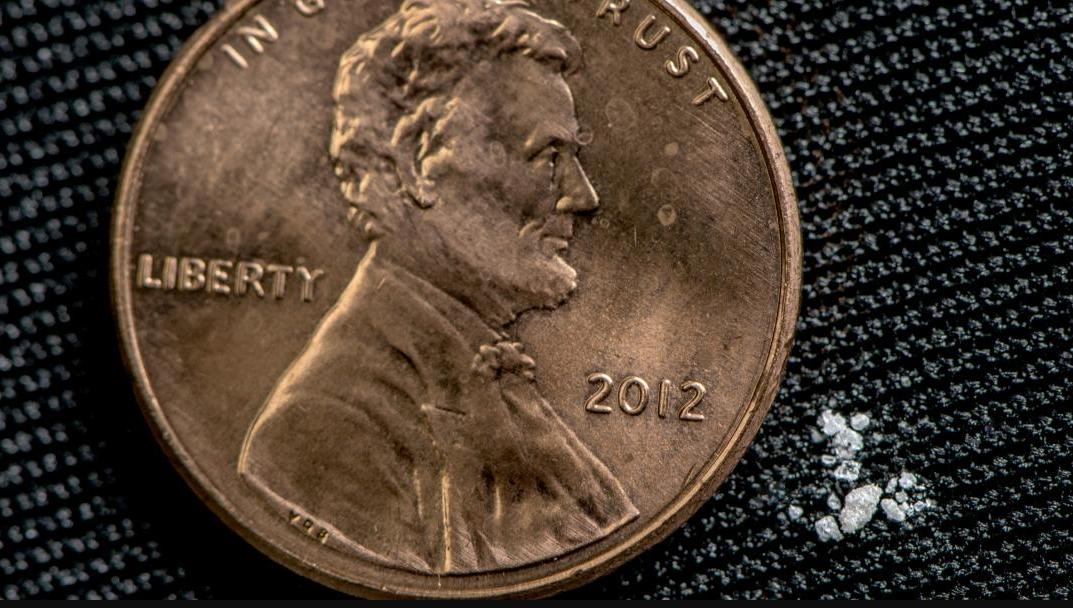
“The proliferation into prescription drug lookalikes show that four out of 10 pills that are recovered today by the Los Angeles Police Department, and across this country, contain a deadly and fatal amount of fentanyl,” LAPD Chief Michel Moore said.
The DEA notes that those pills are largely made by two Mexican drug cartels, the Sinaloa Cartel and the Jalisco (CJNG) Cartel, to look identical to real prescription medications, including OxyContin®, Percocet®, and Xanax®, and they are often deadly. The two cartels using chemicals largely sourced from China, are primarily responsible for the vast majority of the fentanyl that is being trafficked in communities across the United States.
Fentanyl Crisis
Fentanyl to potentially kill entire population of North America seized
DEA & other agencies confiscated more than 379 million deadly doses of fentanyl in 2022. It remains the deadliest drug threat facing the U.S.
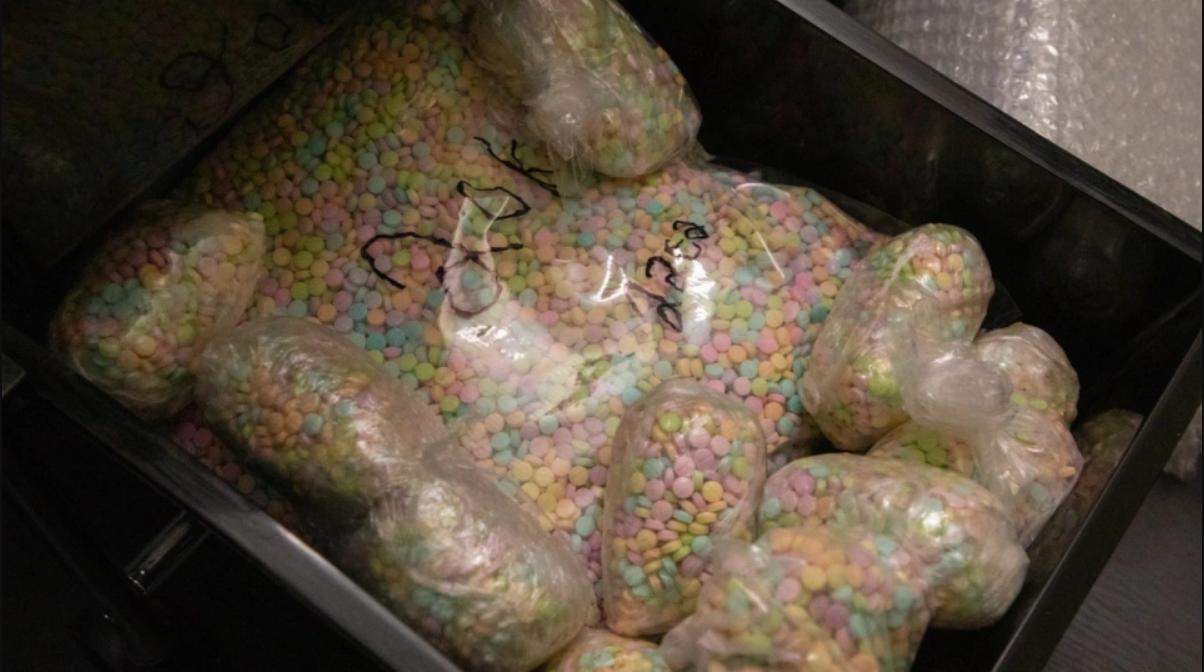
WASHINGTON – In a press conference this week, U.S. Drug Enforcement Administration Administrator Anne Milgram told reporters that the DEA and other federal agencies confiscated more than 379 million deadly doses of fentanyl this year, which was enough to potentially kill every American.
“These seizures – enough deadly doses of fentanyl to kill every American – reflect DEA’s unwavering commitment to protect Americans and save lives, by tenaciously pursuing those responsible for the trafficking of fentanyl across the United States,” she said.
The DEA head also noted that seizures included 50.6 million fentanyl-laced fake prescription pills and more than 10,000 pounds of fentanyl powder.
Federal officials warn that fentanyl “is a highly addictive man-made opioid that is 50 times more potent than heroin. Just two milligrams of fentanyl, the small amount that fits on the tip of a pencil, is considered a potentially deadly dose.”
The U.S. Drug Enforcement Administration Laboratory has found that, of the fentanyl-laced fake prescription pills analyzed in 2022, six out of ten now contain a potentially lethal dose of fentanyl. This is an increase from DEA’s previous announcement in 2021 that four out of ten fentanyl-laced fake prescription pills were found to contain a potentially lethal dose.
“More than half of the fentanyl-laced fake prescription pills being trafficked in communities across the country now contain a potentially deadly dose of fentanyl. This marks a dramatic increase – from four out of ten to six out of ten – in the number of pills that can kill,” said Administrator Milgram. “These pills are being mass-produced by the Sinaloa Cartel and the Jalisco Cartel in Mexico. Never take a pill that wasn’t prescribed directly to you. Never take a pill from a friend. Never take a pill bought on social media. Just one pill is dangerous and one pill can kill.”
The DEA notes that those pills are largely made by the two Mexican drug cartels look identical to real prescription medications, including OxyContin®, Percocet®, and Xanax®, and they are often deadly. The two cartels using chemicals largely sourced from China, are primarily responsible for the vast majority of the fentanyl that is being trafficked in communities across the United States.
In Los Angeles alone, DEA officials seized more than 7 million fentanyl pills and more than 1,000 pounds of fentanyl powder this year.
DEA lab officials estimate that amount represents more than 38 million potentially deadly doses of the narcotic, which would be enough to kill the entire population of the largest counties in Southern California.
DEA Los Angeles Special Agent in Charge Bill Bodner called the region a “major transshipment hub” for fentanyl and other drugs, and for that reason, his agency is committed to saving lives.
“As people prepare to celebrate the holidays and gather with friends and family let us be mindful of the fentanyl threat that is destroying families across the nation and leaving empty seats at the dinner table this year,” Bodner said. “These seizures represent our tenacious efforts to make our communities safer and our ongoing commitment to save lives.”
Governor Gavin Newsom released the following statement on the end-of-year numbers in California’s comprehensive and historic fight toward ending the opioid epidemic.
“The opioid crisis has touched every part of California, and our nation, this year. As we mourn the many lives lost, California is working harder than ever to fight this crisis and protect people from these dangerous drugs to ensure our communities are kept safe in the first place,” said Governor Newsom. “California is cracking down on the fentanyl crisis – increasing seizures, making resources more available to Californians, and ensuring communities have what they need to combat the immeasurable harm opioids have caused our society, our communities, and our loved ones.”
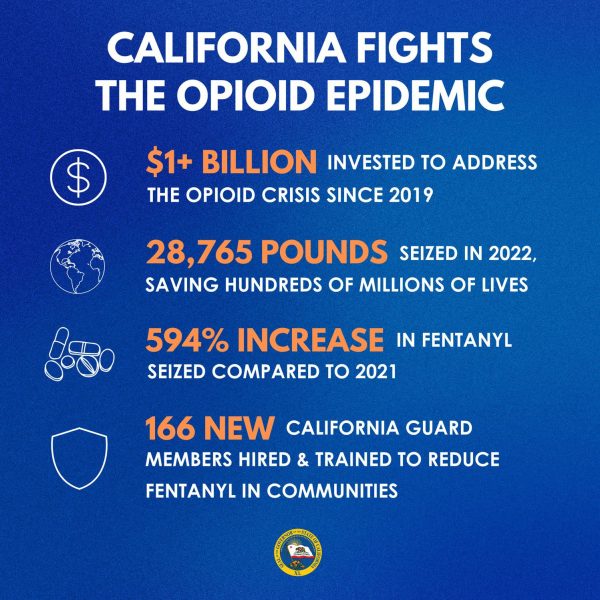
KEY NUMBERS:
- MORE THAN $1 BILLION INVESTED since the beginning of the Newsom Administration to address the opioid crisis, with CalHHS investing $450 Million in the current fiscal year.
- 28,765 POUNDS SEIZED by law enforcement with support from the California National Guard in support of law enforcement during 2022, an estimated street value of more than $230 Million and saving potentially hundreds of millions of lives according to the DEA.
- 594% INCREASE IN FENTANYL SEIZED by law enforcement with help from the California National Guard compared to 2021.
- 166 NEW GUARD MEMBERS hired, trained, and embedded by California’s National Guard to support the Governor’s initiative to reduce deadly fentanyl in communities.
RECENT ACTION: The Department of Health Care Services (DHCS) is making millions of dollars in grants available to address the ongoing opioid epidemic. Today, DHCS announced it will bolster efforts to raise awareness of the life-saving drug Naloxone by working with colleges and universities across California.
On Tuesday, DHCS announced that millions of dollars in grants are available to help improve patient care in the areas of substance use disorder, opioid use disorder, and addictions. Last week, DHCS announced that millions of dollars in new grants were now available to tackle youth opioid use, including schools and other nonprofit organizations.
In July, the state of California received more than $100 million as part of the national opioid settlement with multiple major pharmaceutical companies. And as part of last year’s budget, Newsom provided additional funding to increase the California National Guard’s capacity to combat the fentanyl crisis and support federal, state and local law enforcement counter-narcotic investigations and operations.
Fentanyl remains the deadliest drug threat facing the U.S. as it is a highly addictive synthetic opioid that is 50 times more potent than heroin and 100 times more potent than morphine. Just two milligrams of fentanyl, the small amount that fits on the tip of a pencil, is considered a potentially deadly dose.

(Photo Credit: USDEA)
According to the CDC, 107,622 Americans died of drug poisoning in 2021, with 66 percent of those deaths involving synthetic opioids like fentanyl.
For more information on the dangers of fentanyl, please visit Fentanyl Awareness (dea.gov).
Fentanyl Crisis
Federal health officials hold roundtable on opioid overdose crisis
“Deaths caused by opioids like illicit fentanyl are preventable with naloxone,” said White House advisor Dr. Rahul Gupta
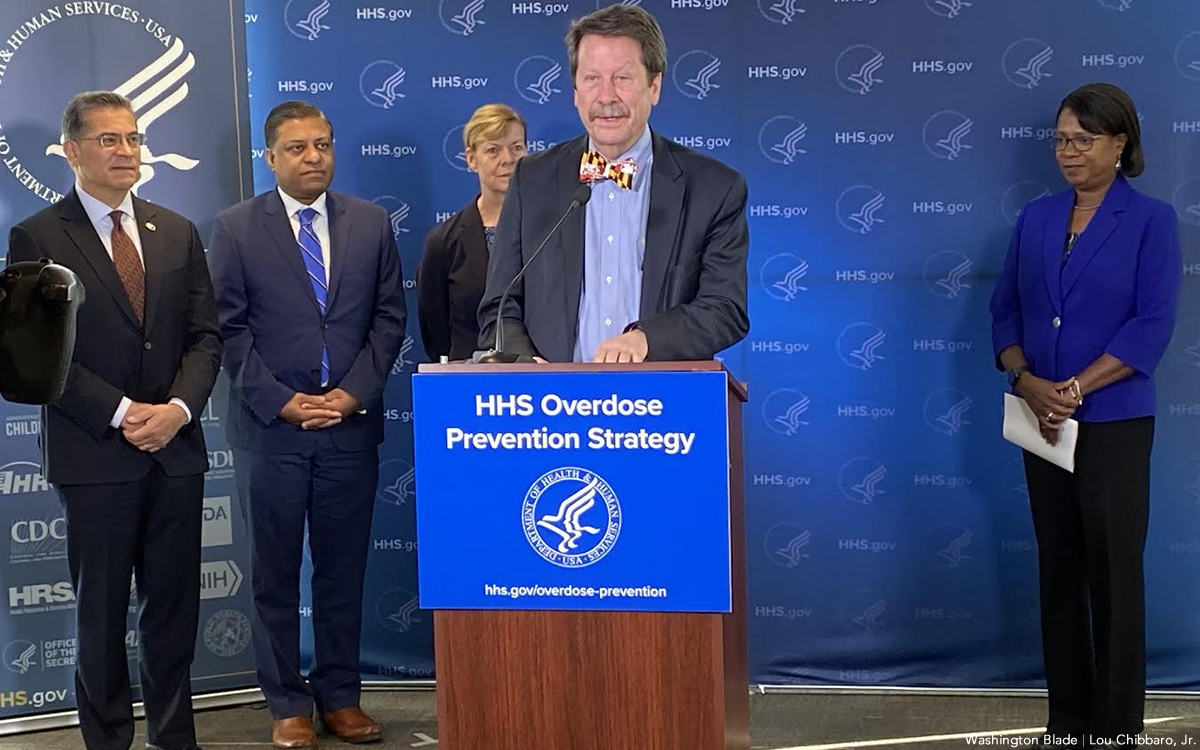
WASHINGTON – U.S. Department of Health and Human Services Secretary Xavier Becerra and four other high level federal health officials held a roundtable community meeting followed by a press conference at D.C.’s Whitman-Walker Health headquarters on Friday to discuss what they said were “groundbreaking” efforts to address and end the nation’s epidemic of deaths from the overdose of opioid drugs.
A statement released by HHS says Becerra and the other officials, including Dr. Rahul Gupta, director of the White House Office of National Drug Control Policy, reached out to Whitman-Walker, which, among other things, operates one of the D.C. metro area’s preeminent substance abuse treatment programs, to commemorate the one-year anniversary HHS’s Overdoes Prevention Strategy program.
“Now, one year after the release of this strategy, our nation is in a much stronger position to treat addiction and save lives,” Becerra said. “We didn’t get here by accident. Thanks to decades of work by advocates, coupled with an unparalleled people-first strategy and unprecedented investment by the Biden-Harris administration, we have made a great deal of progress,” he said.
The officials, including Gupta, pointed out that the Overdose Prevention Strategy over the past year and an updated effort launched this month have focused on greatly expanding availability of the drug overdose antidote medication naloxone.
“Deaths caused by opioids like illicit fentanyl are preventable with naloxone, and today’s announcement means more life-saving naloxone will be in communities across the country,” Gupta said. “The latest data continue to show a hopeful trend of a decreases in overdose deaths, so we must remain focused on fully implementing President Biden’s National Drug Control Strategy that will save tens of thousands of lives by expanding care for substance use disorder, making naloxone more accessible, and dismantling drug trafficking operations,” he said.
In addition to Gupta from the White House, Becerra was joined at the community meeting and press conference by Dr. Miriam Delphin-Rittmon, assistant secretary for the Substance Abuse and Mental Health Services Administration (SAMHSA), which is an arm of HHS; Dr. Debra Houry, acting principal deputy director of the U.S. Centers for Disease Control and Prevention and Dr. Robert Califf, commissioner of the U.S. Food and Drug Administration.
Also participating in the roundtable session and press conference was U.S. Sen. Tammy Baldwin (D-Wis.), the nation’s first out lesbian member of the Senate.
Becerra said he invited Baldwin to participant in the day’s events, among other things, because of her record of advocacy and support for funding of federal substance abuse and overdose prevention programs.
“One area I’ve championed in Congress is increasing access to overdose reversal medication like naloxone,” Baldwin said. “We know that when you increase access to this safe and effective treatment that you save lives,” she said. “And I’m thrilled to see the Biden administration and especially the Food and Drug Administration taking steps to increase access to naloxone.”
Califf told the gathering one of the FDA’s recently launched efforts is to work with drug manufacturers to arrange for naloxone to become an over-the-counter drug that would further expand its availability.
The roundtable discussion session, which included close to 50 participants, including Becerra and the other federal officials, was closed to the press, according to an HHS spokesperson, because among those participating were Whitman-Walker clients and others who receive services and support for what the officials called substance use disorder.
During the press conference that followed, Becerra spoke of how some of those participating in the roundtable discussion were part of Whitman-Walker’s success stories in helping people overcome substance use problems
“We’re here because a year ago we decided to go in a different direction at the federal level,” he said at the press conference. “We decided that we’re not moving fast enough, we’re not moving close enough to where we need to be to try to help communities and those folks at Whitman-Walker who are trying to not just get folks into treatment but to save lives,” Becerra said.
“And that was the great thing about the round table that we just had,” he said. “We heard about how people thrive,” he said, adding, “And one of the clients, Deborah, spoke about how she’s on the verge of getting her degree from college … That’s what we want to see … I want to thank the folks at Whitman-Walker for letting us come today to see how people can thrive and be part of that success.”
Whitman-Walker Health CEO Naseema Shafi told the Washington Blade after the press conference that Whitman-Walker has a long history of partnering with federal government agencies in addressing health issues, including Whitman-Walker’s role as a healthcare facility welcoming the LGBTQ community.
Fentanyl Crisis
Fentanyl Crisis: Deaths in Los Angeles County up 1,280%
Never take a pill from a friend. Never take a pill bought on social media. Just one pill is dangerous and one pill can kill

LOS ANGELES – In a somber press conference Tuesday, officials representing Los Angeles County law enforcement and public health agencies announced that the number of fentanyl-related deaths had leaped upwards by 1,280%, from 109 in 2016 to 1,504 in 2021.
“Tragically, in L.A. County, about four people die each day from a fentanyl overdose and this devastating loss touches families all across the county,” Dr. Barbara Ferrer, the LA County Public Health Director told reporters.
The U.S. Drug Enforcement Administration Laboratory has found that, of the fentanyl-laced fake prescription pills analyzed in 2022, six out of ten now contain a potentially lethal dose of fentanyl. This is an increase from DEA’s previous announcement in 2021 that four out of ten fentanyl-laced fake prescription pills were found to contain a potentially lethal dose.
“More than half of the fentanyl-laced fake prescription pills being trafficked in communities across the country now contain a potentially deadly dose of fentanyl. This marks a dramatic increase – from four out of ten to six out of ten – in the number of pills that can kill,” said Administrator Anne Milgram. “These pills are being mass-produced by the Sinaloa Cartel and the Jalisco Cartel in Mexico. Never take a pill that wasn’t prescribed directly to you. Never take a pill from a friend. Never take a pill bought on social media. Just one pill is dangerous and one pill can kill.”
“The proliferation into prescription drug lookalikes show that four out of 10 pills that are recovered today by the Los Angeles Police Department, and across this country, contain a deadly and fatal amount of fentanyl,” LAPD Chief Michel Moore said.
The DEA notes that those pills are largely made by two Mexican drug cartels, the Sinaloa Cartel and the Jalisco (CJNG) Cartel, to look identical to real prescription medications, including OxyContin®, Percocet®, and Xanax®, and they are often deadly. The two cartels using chemicals largely sourced from China, are primarily responsible for the vast majority of the fentanyl that is being trafficked in communities across the United States.
In the press conference L.A. County officials noted that a working group made up of law enforcement, health officials, the district attorney’s office, school leaders, community advocates and parents has been created.
“Each of us comes from a different place, the tools that we bring to the table are different, but when combine all of our tools together, we believe that we will be able to have the greatest impact for the wellbeing of our community,” L.A. County District Attorney George Gascón said.
According to the Gascón, the plan is to provide more education about the risks, prevention through treatment and enforcement by going after the suppliers.
“So, we’re here to commit ourselves to our continued efforts to combat the number one drug problem in America today,” Chief Moore added.
Fentanyl remains the deadliest drug threat facing the U.S. as it is a highly addictive synthetic opioid that is 50 times more potent than heroin and 100 times more potent than morphine. Just two milligrams of fentanyl, the small amount that fits on the tip of a pencil, is considered a potentially deadly dose.
According to the CDC, 107,622 Americans died of drug poisoning in 2021, with 66 percent of those deaths involving synthetic opioids like fentanyl.
For more information on the dangers of fentanyl, please visit Fentanyl Awareness (dea.gov).
Read the LA County Report:
-

 COMMENTARY4 days ago
COMMENTARY4 days agoUSAID’s demise: America’s global betrayal of trust
-

 a&e features4 days ago
a&e features4 days agoHow this Texas drag king reclaimed their identity through Chicano-inspired drag
-

 Obituary4 days ago
Obituary4 days agoThe queer community mourns the loss of trailblazer Jewel Thais-Williams
-

 Television3 days ago
Television3 days agoICYMI: ‘Overcompensating’ a surprisingly sweet queer treat
-

 Arts & Entertainment5 days ago
Arts & Entertainment5 days agoMary Lambert Returns With a Battle Cry in new single, “The Tempest”
-

 Breaking News1 day ago
Breaking News1 day agoProject Angel Food loses $340,000 grant to feed people living with HIV
-

 Opinions2 days ago
Opinions2 days agoThe psychology of a queer Trump supporter: Navigating identity, ideology, and internal conflict
-
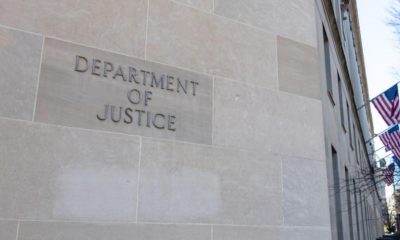
 Breaking News1 day ago
Breaking News1 day agoTrump administration sues California over trans student-athletes
-

 Living2 days ago
Living2 days agoFaithfully queer: Finding God and growth in Modern Orthodoxy
-

 COMMENTARY11 hours ago
COMMENTARY11 hours agoWhat if doctors could deny you insulin for being gay?




